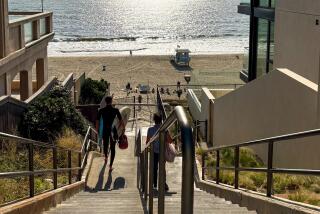Short Day’s Journey to Famed Playwright’s Home
- Share via
When Eugene O’Neill, among America’s most distinguished 20th century playwrights, was awarded the Nobel Prize for literature in 1936, he used the prize money to build Tao House, his estate in the hills above Danville, Calif. In his seven years at the hilltop retreat, O’Neill wrote the final works of his life, the often autobiographical masterworks “Long Day’s Journey Into Night,” “The Iceman Cometh,” “Hughie,” “A Touch of the Poet” and “A Moon for the Misbegotten.”
O’Neill’s house, now a national historic site, is open for twice-daily guided tours; reservations are required. Most visitors board a National Park Service shuttle from downtown Danville to O’Neill’s home. Few visitors realize they can take a short hike from adjacent Las Trampas Regional Wilderness to the historic site. Rangers welcome hikers but note that tour reservations are still required for the O’Neill house.
Tao House reflects O’Neill’s interest in Eastern thought and the passion of his wife, actress Carlotta Monterey, for Asian art and decor. The house is an unusual, even odd, blend of Spanish-California Mission architecture with Chinese design elements.
O’Neill’s study is particularly intriguing to many admirers of the playwright. His workplace, restored with original and period furnishings, features a fireplace and private porch--a perfect place to write.
And write he did, in strict seclusion; Carlotta was a wary gatekeeper who allowed few people to disturb her husband’s work. While O’Neill wrote, Carlotta pursued her own creative vision with Tao House. Deep blue ceilings, mirrors and “opium” couches are among her decorating touches. Outdoors, the garden walkway zigzags--a Chinese-influenced design intended to throw visiting evil spirits off track.
Park rangers and docents tell the story of O’Neill’s difficult early years, of the itinerant life of a theater family always on the road, of alcoholism and his mother’s addiction to morphine. By the 1920s, O’Neill had reinvigorated American theater with three Pulitzer Prize-winning plays: “Beyond the Horizon,” “Anna Christie” and “Strange Interlude.” Still, family tragedy intruded: Within three years of his first successful play on Broadway, his mother, father and older brother died. These great losses, and resulting feelings of guilt and grief, plagued the playwright for the rest of his life. At Tao House, O’Neill became ever more autobiographical. The Tyrone family in “Long Day’s Journey Into Night” (for which O’Neill received a fourth Pulitzer, posthumously) is almost a nonfiction account of his own family.
Looking out at the beautiful hills and valleys surrounding Tao House, it’s easy to conclude that this California scene was no inspiration for, and had no relation to, O’Neill’s work. Park Superintendent Glenn Fuller feels differently: “The effect of Tao House and these surroundings provided a setting conducive to reflection and the deep probing of the past that was so integral to his work.”
O’Neill was afflicted with a rare degenerative nerve disorder that caused tremors in his hand. As his condition worsened he was literally unable to put pencil to paper; this resulted in a creative shutdown, and he never completed another play after 1943.
World War II on the home front resulted in a manpower shortage and a loss of the kind of help the O’Neills required--drivers, housekeepers, etc.--necessary to maintain a life at Tao House. The O’Neills moved to Boston, where he died in 1953.
Eugene O’Neill National Historic Site is open 8 a.m. to 4:30 p.m. Wednesdays through Sundays except for major holidays. Home tours (at 10 a.m. and 12:30 p.m.) are free, and the National Park Service provides a shuttle van (also free) from Danville (pickup location provided at the time of reservation). Tours are at 10 a.m. and 1 p.m.
Directions to trail head: From Interstate 680 in Danville, exit on El Cerro Road and head west to Danville Boulevard. Turn right and go one block. Turn left on Del Amigo Road and follow it as it zigzags 0.5 mile to Starview Drive. Bear left and continue to the signed trail head on the right side of the road. Park on Starview Drive (some restrictions posted) and not on the adjoining private road.
The hike: Follow signed Del Amigo Trail along a fence line, soon leaving residences behind. You’ll pass through a green gate and contour onto an open, lupine-splashed slope with views over Danville.
After about 0.6 mile you’ll join signed Virgil Williams Trail. You’ll travel among ferns and old oaks that frame views of Mt. Diablo to the east.
The path dips to intersect Madrone Trail (a fire road). Turn right and cross a meadow, angling 0.2 mile toward a pond and the barn in the back of Eugene O’Neill’s home. Open the back gate and enter the National Historic Site. A special visitors entrance is on the side of Tao House.
(BEGIN TEXT OF INFOBOX / INFOGRAPHIC)
Del Amigo and Virgil Williams Trails WHERE: Eugene O’Neill National Historic Site.
DISTANCE: From Starview Drive to Eugene O’Neill NHS is 3 miles round trip with 400-foot elevation gain; longer hikes possible.
TERRAIN: Rolling hills at the base of Mt. Diablo.
HIGHLIGHTS: Home, haunts and landscape of playwright Eugene O’Neill
DEGREE OF DIFFICULTY: Moderate
FOR MORE INFORMATION: Eugene O’Neill National Historic Site, P.O. Box 280, Danville, CA 94526; tel. (925) 838-0249.
More to Read
Sign up for The Wild
We’ll help you find the best places to hike, bike and run, as well as the perfect silent spots for meditation and yoga.
You may occasionally receive promotional content from the Los Angeles Times.






